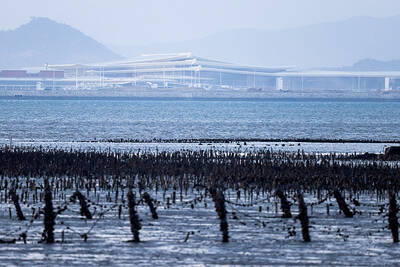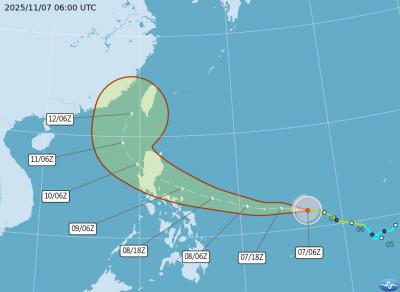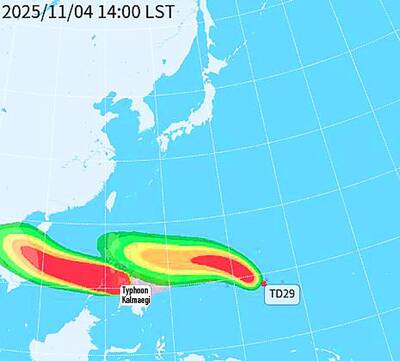The Ministry of Digital Affairs (MODA) has mapped out a five-year strategic plan to promote the development and use of artificial intelligence (AI) as a tool to improve the efficiency of government operations, it said in a report to the Legislative Yuan.
The government AI development strategic plan, expected to be implemented from 2026, lays out five strategies. First, encourage government agencies to develop smart services, including building smart counters and smart secretaries, so people can apply for state services with the help of AI tools.
Second, build automated administrative services.

Photo: Hsu Tzu-ling, Taipei Times
The ministry said it would guide government agencies in the use of AI to assist public servants in routine and complex work, help with system construction and information security maintenance, and focus on case review or decisionmaking assistance in specific business areas.
Third, optimize AI models.
The ministry said it aims to create government data fabric and use privacy enhancement technology to allow government data to be better transmitted and used across agencies while ensuring security and anonymity of sensitive data.
Fourth, create smart services that ensure digital inclusion and equal opportunity for all and take into account the need to protect the fair participation of vulnerable groups.
Fifth, establish an environment for AI applications. The ministry would establish a secure and compliant data sharing environment so various agencies can obtain required information safely and efficiently.
The ministry has also devised several complementary measures for the government AI development plan, including the development of an AI application manual for the public sector, with a beta version of the manual to become available for trial use by government agencies before the end of this year.
In related news, Minister of Digital Affairs Huang Yen-nun (黃彥男) on Monday said that that the ministry is planning to launch a program by spending NT$10 billion (US$310.8 million) to cultivate local start-ups in AI development.
Speaking at an AI forum organized by Shih Hsin University, Huang said the ministry would disclose the details of the NT$10 billion plan at the end of this year.
The investment is scheduled to start next year aiming to help at least 20 AI start-ups to grow and allow them to raise funds on the capital market, he added.
Likening the AI boom to the industrial revolution, Huang said Taiwan should catch up with trends to add momentum to economic growth by pushing up industrial productivity.
Otherwise, the nation would be left behind, he said.
To develop AI, Taiwan needs technologies, talent and resources, he said.
However, the country is full of small and medium-sized enterprises with limited capital so financial assistance from the government is a must, he added.
A white paper published by the Small and Medium Enterprises (SME) and Startup Administration of the Ministry of Economic Affairs showed that the number of Taiwan’s SMEs hit 1.63 million as of the end of 2022.
According to the Standards for Identifying Small and Medium- sized Enterprises, an SME is a business that has paid-in capital of no more than NT$100 million or has fewer than 200 regular employees.
Capital is a critical factor for AI start-ups to expand, so MODA has secured NT$10 billion in financial assistance from the National Development Fund of the Executive Yuan to help these smaller companies, Huang said, adding that the money would be spent over 10 years from next year.
The AI start-up program is expected to result in capital formation ranging NT$100 billion to NT$200 billion in the local digital industry and raise job openings by about 10,000, while at least 20 companies would have the potential to raise funds from the capital market, he said.
The NT$10 billion spent in the 10 years is expected to create about NT$1 trillion in production value, he added.

Three Taiwanese airlines have prohibited passengers from packing Bluetooth earbuds and their charger cases in checked luggage. EVA Air and Uni Air said that Bluetooth earbuds and charger cases are categorized as portable electronic devices, which should be switched off if they are placed in checked luggage based on international aviation safety regulations. They must not be in standby or sleep mode. However, as charging would continue when earbuds are placed in the charger cases, which would contravene international aviation regulations, their cases must be carried as hand luggage, they said. Tigerair Taiwan said that earbud charger cases are equipped

UNILATERAL MOVES: Officials have raised concerns that Beijing could try to exert economic control over Kinmen in a key development plan next year The Civil Aviation Administration (CAA) yesterday said that China has so far failed to provide any information about a new airport expected to open next year that is less than 10km from a Taiwanese airport, raising flight safety concerns. Xiamen Xiangan International Airport is only about 3km at its closest point from the islands in Kinmen County — the scene of on-off fighting during the Cold War — and construction work can be seen and heard clearly from the Taiwan side. In a written statement sent to Reuters, the CAA said that airports close to each other need detailed advanced

Tropical Storm Fung-Wong would likely strengthen into a typhoon later today as it continues moving westward across the Pacific before heading in Taiwan’s direction next week, the Central Weather Administration (CWA) said. As of 8am, Fung-Wong was about 2,190km east-southeast of Cape Oluanpi (鵝鑾鼻), Taiwan’s southernmost point, moving westward at 25kph and possibly accelerating to 31kph, CWA data showed. The tropical storm is currently over waters east of the Philippines and still far from Taiwan, CWA forecaster Tseng Chao-cheng (曾昭誠) said, adding that it could likely strengthen into a typhoon later in the day. It is forecast to reach the South China Sea

WEATHER Typhoon forming: CWA A tropical depression is expected to form into a typhoon as early as today, the Central Weather Administration (CWA) said yesterday, adding that the storm’s path remains uncertain. Before the weekend, it would move toward the Philippines, the agency said. Some time around Monday next week, it might reach a turning point, either veering north toward waters east of Taiwan or continuing westward across the Philippines, the CWA said. Meanwhile, the eye of Typhoon Kalmaegi was 1,310km south-southeast of Oluanpi (鵝鑾鼻), Taiwan’s southernmost point, as of 2am yesterday, it said. The storm is forecast to move through central